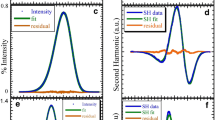Abstract
Since solvent relaxation (SR) exclusively depends on the physical properties of the dye environment, SR spectroscopy of defined located labels in amphiphilic assemblies accomplishes the characterisation of specific domains. The most accurate way to characterise SR is the determination of the time-dependent Stokes shift. The time course of the Stokes shift, expressed as a solvent relaxation time, gives information about both the rigidity and polarity of the dye environment. The absolute value of the Stokes shift following the excitation is correlated with the polarity of the probed region. The validity of this approach for the investigation of phospholipid bilayers is illustrated by listing the parameters influencing the SR kinetics of appropriate membrane labels: membrane curvature, percentage of phosphatidylserine (PS) in small unilamell vesicles (SUV), addition of Ca2+ ions, binding of vitamin-K dependent proteins, percentage of diether-lipids in phosphatidylcholine (PC)-vesicles, and temperature.
Similar content being viewed by others
References
M.R. Eftink: inTopics in Fluorescence Spectroscopy: Principles (Lakowicz J.R., Ed.), Plenum Press, New York, 1992, p. 53.
B.W. Van der Meer, G. Coker, and S.Y.S. Chen:Resonance Energy Transfer Theory and Data, VCH Verlag, Weinheim, 1994.
C.D. Stubbs and B.W. Williams: inTopics in Fluorescence Spectroscopy: Biochemical Applications (Lakowicz J.R., Ed.), Plenum Press, New York, 1992, p. 231.
G. Duportail and P. Lianos: inVesicles (Rosoff M., Ed.), Marcell Dekker, New York, 1996, p. 296.
N.G. Bakshiev: Opt. Spektrosk. (USSR) 16 (1964) 446.
Y.T. Mazurenko and N.G. Bakshiev: Opt. Spektrosk. (USSR)28 (1970) 490.
W. Liptay: inExcited States, Vol. 1 (Lim E.C., Ed.), Academic Press, New York, 1974, p. 129.
M.L. Horng, J.A. Gardecki, A. Papazyan, and M. Maroncelli: J. Phys. Chem.99 (1995) 17320.
S. Mukherje and A. Chattopadhyay: J. Fluorescence5 (1995) 237.
R. Hutterer, F.W. Schneider, N. Perez, H. Ruf, and M. Hof: J. Flour.3 (1993) 257.
M. Hof, R. Hutterer, N. Perez, H. Ruf, and F.W. Schneider: Biophys. Chem.52 (1994) 165.
R. Hutterer, F.W. Schneider, H. Sprinz, and M. Hlf: Biophys. Chem.61 (1996) 151.
R. Hutterer and M. Hof: inFluorescence Microscopy and Fluorescence Probes (Slavik J., Ed.), Plenum Press, New York, 1996, p. 232.
R. Hutterer, F.W. Schneider, H. Lanig, and M. Hof: Biochim. Biophys. Acta1323 (1997) 195.
R. Hutterer, F.W. Schneider, V. Fidler, E. Grell, and M. Hof: J. Fluorescence7 (1997) 161S.
R. Hutterer, Schneider F.W., and M. Hof: J. Fluorescence7 (1997) 27.
M.E. Jones and B.R. Lentz: Biochem.25 (1986) 567.
S.W. Tendian and B.R. Lentz: Biochem.29 (1990) 6720.
R. Hutterer, W.Th. Hermens, R. Wagenvoord, and M. Hof: in preparation.
G.A. Cutsforth, R.N. Whittaker, and B.R. Lentz: Biochem.28 (1989) 7453.
A. Sommer, F. Paltauf, and A. Hermetter: Biochem.29 (1990) 11134.
A. Hermetter, E. Prenner, J. Loidl, E. Kalb, A. Sommer, and F. Paltauf: inFluorescence Spectroscopy (Wolfbeis O.S., Ed.), Springer Verlag, Berlin, 1993, p. 149.
Author information
Authors and Affiliations
Corresponding author
Rights and permissions
About this article
Cite this article
Hof, M., Hutterer, R. Solvent relaxation of fluorescent labels as a new tool for the detection of polarity and rigidity changes in membranes. Czech J Phys 48, 435–441 (1998). https://doi.org/10.1023/A:1021241808793
Received:
Issue Date:
DOI: https://doi.org/10.1023/A:1021241808793




